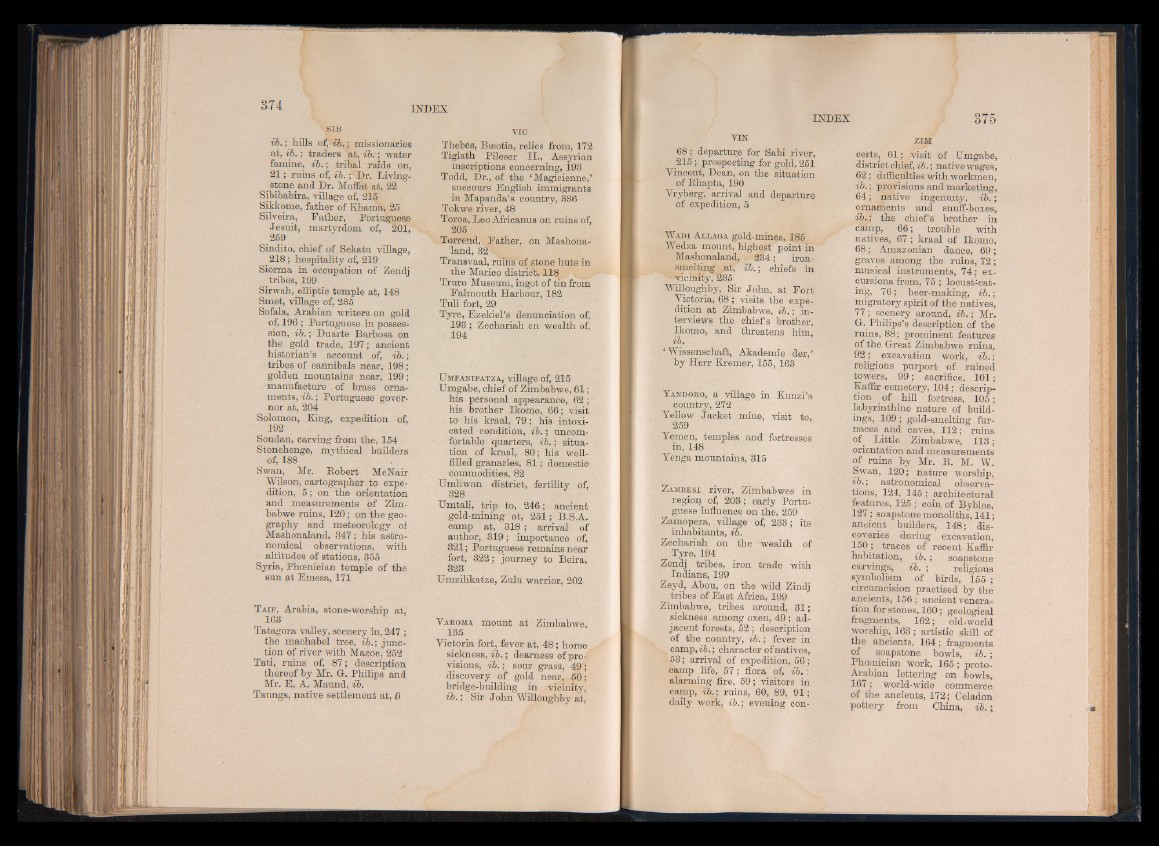
S IB
ib. ; hills of, ib. ; missionaries
at, ib. ; traders at, ib: ; water
famine, ib. ; tribal raids on,
21 ; ruins of, ib. ; Dr. Livingstone
and Dr. Moffat at, 22
Sibibabira, village of, 215
Sikkome, father of Khama, 25
Silveira, Father, Portuguese
Jesuit, martyrdom of, 2 0 1 ,
259
Sindito, chief of Sekatu village,
218 ; hospitality of, 219
Siorma in occupation of Zendj
tribes, 199
Sirwah, elliptic temple at, 148
Smet, village of, 285
Sofala, Arabian writers on gold
of, 196 ; Portuguese in possession,
ib. ; Duarte Barbosa on
the gold trade, 197 ; ancient
historian’s account of, ib. ;
tribes of cannibals near, 198 ;
golden mountains near, 199 ;
manufacture of brass ornaments,
ib. ; Portuguese governor
at, 204
Solomon, King, expedition of,
192
Soudan, carving from the, 154
Stonehenge, mythical builders
of, 188
Swan, Mr. Bobert McNair
Wilson, cartographer to expedition,
5 ; on the orientation
and measurements of Zimbabwe
ruins, 1 2 0 ; on the geography
and meteorology of
Mashonaland, 347 ; his astronomical
observations, with
■ altitudes of stations, 355
Syria, Phoenician temple of the
sun at Emesa, 171
Taif, Arabia, stone-worship at,
168
Tatagora valley, scenery in, 247 ;
the machabel tree, ib.; junction
of river with Mazoe, 252
Tati, ruins of, 87; description
thereof by Mr. G. Philips and
Mr. E. A. Maund, ib.
Taungs, native settlement at, B
VIC
Thebes, Bceotia, relics from, 172
Tiglath Pileser II., Assyrian
inscriptions concerning, 193
Todd, Dr., of the ‘Magicienne,’
succours English immigrants
in Mapanda’s country, 336
Tokwe river, 48
Toroa, Leo Africanus on ruins of,
205 .
Torrend, Father, on Mashonaland,
32
Transvaal, ruins of stone huts in
the Marico district, 118
Truro Museum, ingot of tin from
Falmouth Harbour, 182
Tuli fort, 29
Tyre, Ezekiel’s denunciation of,
193 ; Zechariah on wealth of,
194
U m f a n i p a t z a , village of, 215
Umgabe, chief of Zimbabwe, 61 ;
his personal appearance, 62 ;
his brother Ikomo, 66 ; visit
■ to his kraal, 79 ; ids intoxicated
condition, ib. ; uncomfortable
quarters, ib. ; situation
of kraal, 80; his well-
filled granaries, 81 ; domestic
commodities, 82
Umliwan district, fertility of,
328
Umtali, trip to, 246 ; ancient
gold-mining at, 251 ; B.S.A.
camp at, 318 ; arrival of
author, 319 ; importance of,
321 ; Portuguese remains near
fort, 322 ; journey to Beira,
323
Umzilikatze, Zulu warrior, 202
V a b o m a mount at Zimbabwe,
135
Victoria fort, fever at, 48 ; horse
sickness, ib. ; dearness of provisions,
ib. ; sour grass, 49 ;
discovery of gold near, 50;
bridge-building in vicinity,
ib. ; Sir John Willoughby at,
6 8 ; departure for Sabi river,
215 ; prospecting for gold, 251
Vincent, Dean, on the situation
of Bhapta, 190
Vryberg, arrival and departure
of expedition, 5
W a d i A l l a g a gold-mines, 185
Wedza mount, highest point in
Mashonaland, 234; iron-
smelting at, ib.; chiefs in
vicinity, '235
Willoughby, Sir John, at Fort
Victoria, 68 ; visits the expedition
at Zimbabwe, ib.; interviews
the chiefs brother,
Ikomo, and threatens him,
ib.
‘Wissenschaft, Akademie der,’
by Herr Kremer, 155, 163
Y a n d o b o , a village in Kunzi’s
country, 272
Yellow Jacket mine, visit to,
259
Yemen, temples and fortresses
in, 148
Yenga mountains, 315
Z a m b e s i river, Zimbabwes in
region of, 203; early Portuguese
influence on the, 259
Zamopera, village of, 233; its
inhabitants, ib.
Zechariah on the wealth of
Tyre, 194
Zendj tribes, iron trade with
Indians, 199
Zeyd, Abou, on the wild Zindj
tribes of East Africa, 199
Zimbabwe, tribes around, 31 ;
sickness among oxen, 49 ; adjacent
forests, 52 ; description
of the country, ib. ; fever in
camp,i&. ; character of natives,
53 ; arrival of expedition, 56 ;
camp life, 57 ; flora of, ib. \
alarming fire, 59 ; visitors in
camp, ib. ; ruins, 60, 89, 91 ;
daily work, ib.; evening concerts,
61; visit of Umgabe,
district chief, ib. ; nativewages,
62 ; difficulties with workmen,
ib. ; provisions and marketing,
64 ; native ingenuity, ib. ;
ornaments and snuff-boxes,
ib.; the chiefs brother in
camp, 6 6 ; trouble with
natives, 67 ; kraal of Ikomo,
68 ; Amazonian dance, 69 ;
graves among the ruins, 72 ;
musical instruments, 74; excursions
from, 75 ; locusfeat-
ing, 76; beer-making, ib. ;
migratory spirit of the natives,
77 ; scenery around, ib. ; Mr.
G. Philips’s description of the
ruins, 8 8 ; prominent features
of the Great Zimbabwe ruins,
92 ; excavation work, ib. ;
religious purport of ruined
towers, 99 ; sacrifice, 101 ;
Kaffir cemetery, 104 ; description
of hill fortress, 105 ;
labyrinthine nature of build-
ings, 109 ; gold-smelting furnaces
and caves, 112 ; ruins
of Little Zimbabwe, 113 ;
orientation and measurements
of ruins by Mr. B. M. W.
Swan, 120 ; nature worship,
ib.; astronomical observations,
124, 145 ; architectural
features, 125 ; coin of Byblos,
127 ; soapstone monoliths, 141 ;
ancient builders, 148; discoveries
during excavation,
150 ; traces of recent Kaffir
habitation, ib. ; soapstone
carvings, ib. ; religious
symbolism of birds, 155 ;
circumcision practised by the
ancients, 156 ; ancient veneration
for stones, 160 ; geological
fragments, 162 ; old-world
worship, 163 ; artistic skill of
the ancients, 164 ; fragments
of soapstone bowls, ib. ;
Phoenician work, 165; proto-
Arabian lettering on bowls,
167 ; world-wide commerce
of the ancients, 172; Celadon
pottery from China, ib. ;